
Desmarestia herbacea
Stubby Acid Weed, Broad-bladed Acid Weed, Coarse Acid Kelp
21 July 2024
Tonquin Beach, Templar Channel, Vancouver Island, B.C., Canada
Tide: 0.4 feet at 07:43 PDT (measured at Tofino Tidal Station)
Weather: Light drizzle and fog, wind variable 0-10 km/hour, sea rippled, no swell, some residual oceanic waves, humidity 99%, 14 ˚C.
Moon: Full Moon (3:17 am Full Moon, 16 days); Next Phase, Third Quarter, 27 July 2024 at 7:51 pm PDT; Previous Phase, Full Moon, 21 July 2024 at 3:17 am PDT.
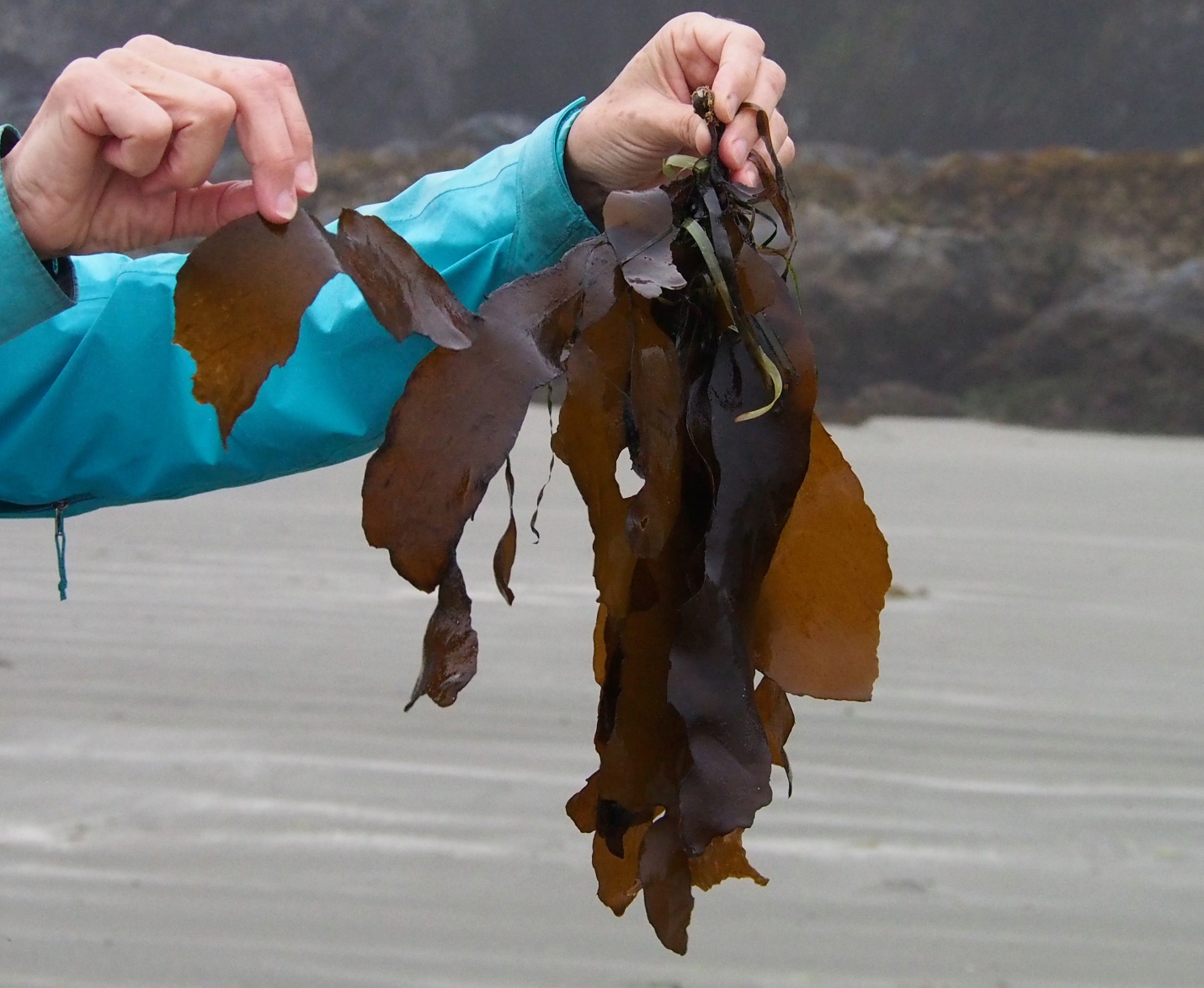
Figure 1: Desmarestia herbacea – a cast ashore individual was encountered this day. Tonquin Beach, Templar Channel, Vancouver Island, B.C., Canada. July 21, 2024. Photo ID 27708 ©Seaweedwhisperings.com
Person 1:
Floating.
Uplifting.
Oars.
Paddles.
Notice I want to use very short phrases or single word descriptions.
Its central axis is overshadowed by its conspicuously short, broad blades.
Narrow mid-rib on central axis.
I can’t quite describe the feel / texture of the thallus..., it’s not quite any of the following; smooth, rough, coarse, slimy... what is that texture?
The form of this Desmarestia has a lighter, less-tangled energy to it compared to other species..., content, gently playful, may be even carefree.
Blades have bladelets off them; most very constricted at the base.
I get that the multiple broad bladelets give Desmarestia herbacea the ability to effortlessly float.
Ends of blades are bluntly rounded.
Wonder if this seaweed can get “blunt” and belligerent if not allowed to “float” the way it wants?
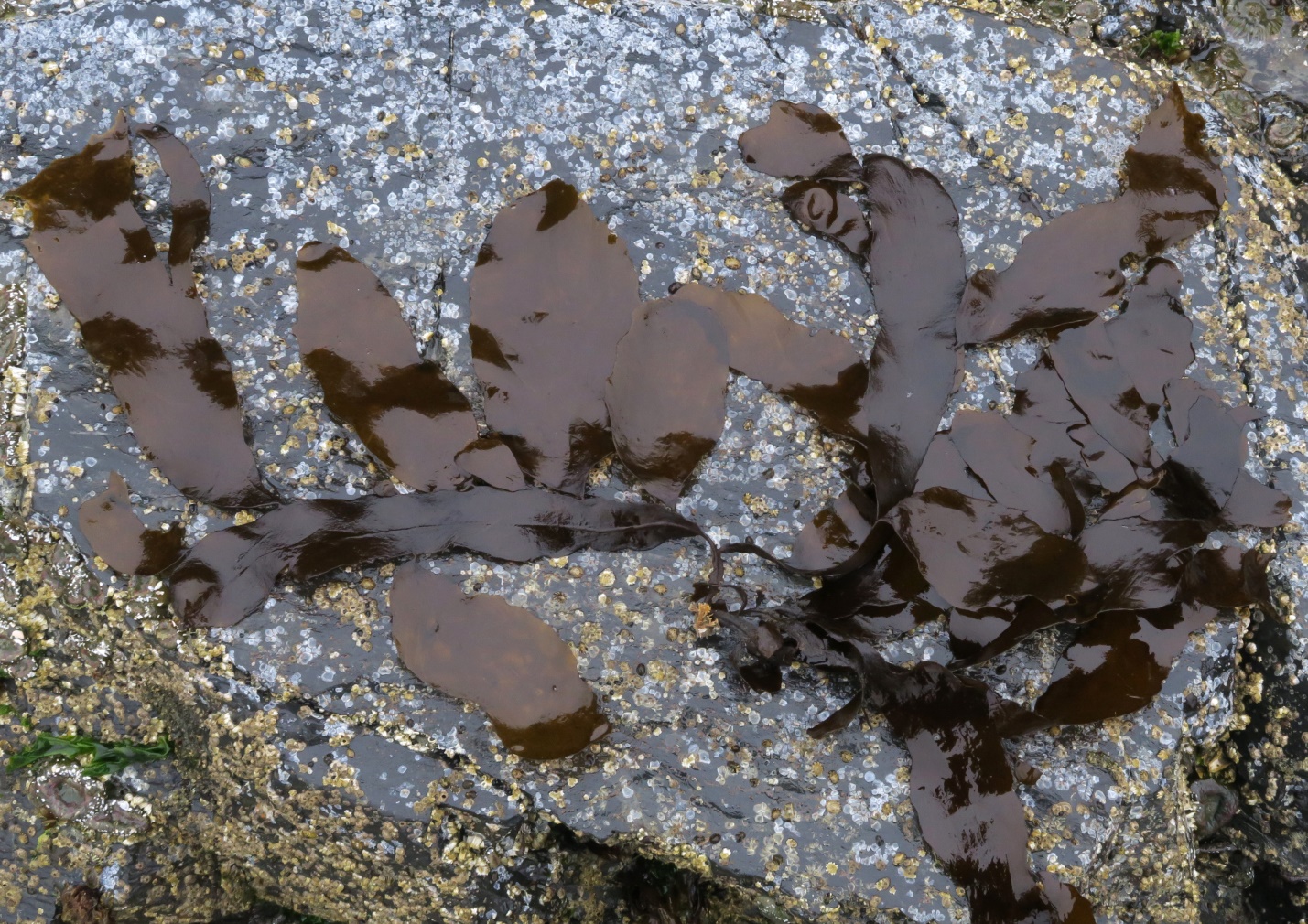
Figure 2: Spread out on a nearby rock, the structure of this brown alga is easier to comprehend. The central blade is like a flat strap and branchlets grow from both sides in a pinnate pattern. To the right three more thalli are left not delineated. Tonquin Beach, Templar Channel, Vancouver Island, B.C., Canada. July 21, 2024. Photo ID 27709 ©Seaweedwhisperings.com
Person 2:
Morphology with the Desmarestia genus is tricky, but this species looks and feels distinctive.
Unsure while in the field of the correct scientific name, we thought of calling it Broad-bladed Desmarestia, but then I thought, no, it’s both broad and short in the blades – so ‘stubby’ is a better descriptor.
In fact the blades are so broad that when laid side by side along the central strap (blade) they overlap each other.
The central axis looks a darker color and seems “older” than the side bladelets.
The central axis blade of the thallus has a prominent midrib and the side blades do have a midrib but it is nowhere near as prominent.
In some ways this seaweed reminds me of the Desmarestia version of Dilsea californica. It is a dark caramel brown that can be even chestnut or darker in certain lights and many of the broad side blades are tattered and worn on the edges and some even are sickle shaped.
The holdfast looks almost as if it was “poured” into the substrate until a sufficient disc was established and then it was “good to go”. Functionality taken care of and now the thallus can grow.
Poured into.
Stubby.
There is a feel of a kind of clumsy or first-attempt energy here. Or maybe it’s actually a bit over-generous with its own efforts – grows a bit too big before it realizes it.
Or is it more enthusiastic growth in length and breadth and stubby is the natural result? More scientifically we could call this lateral two-dimensional growth, but the feel of it is almost like the energy pours out into a flat sheet in a smoothly expansive fashion.
In the Desmarestia group I think no one would claim this species as having a ‘beautiful’ look, but they would note that it is distinctive.
So in comparison does this one get teased? Unappreciated?
Certainly the blades are also very flat and smooth. They are simple broad sheets of algal photosynthesizing material and this works well for them.
This seaweed doesn’t have a hurt or resentful or holding-grudge-from-past-hurts energy; it feels very forgiving. And looking at the individual we found today I just now realized that several of the blades are “damaged” and I don’t see bleaching. Is this species very low in the self-destructive and unintentionally-destructive-to-others sulfuric acid notable to the genus? Maybe so.
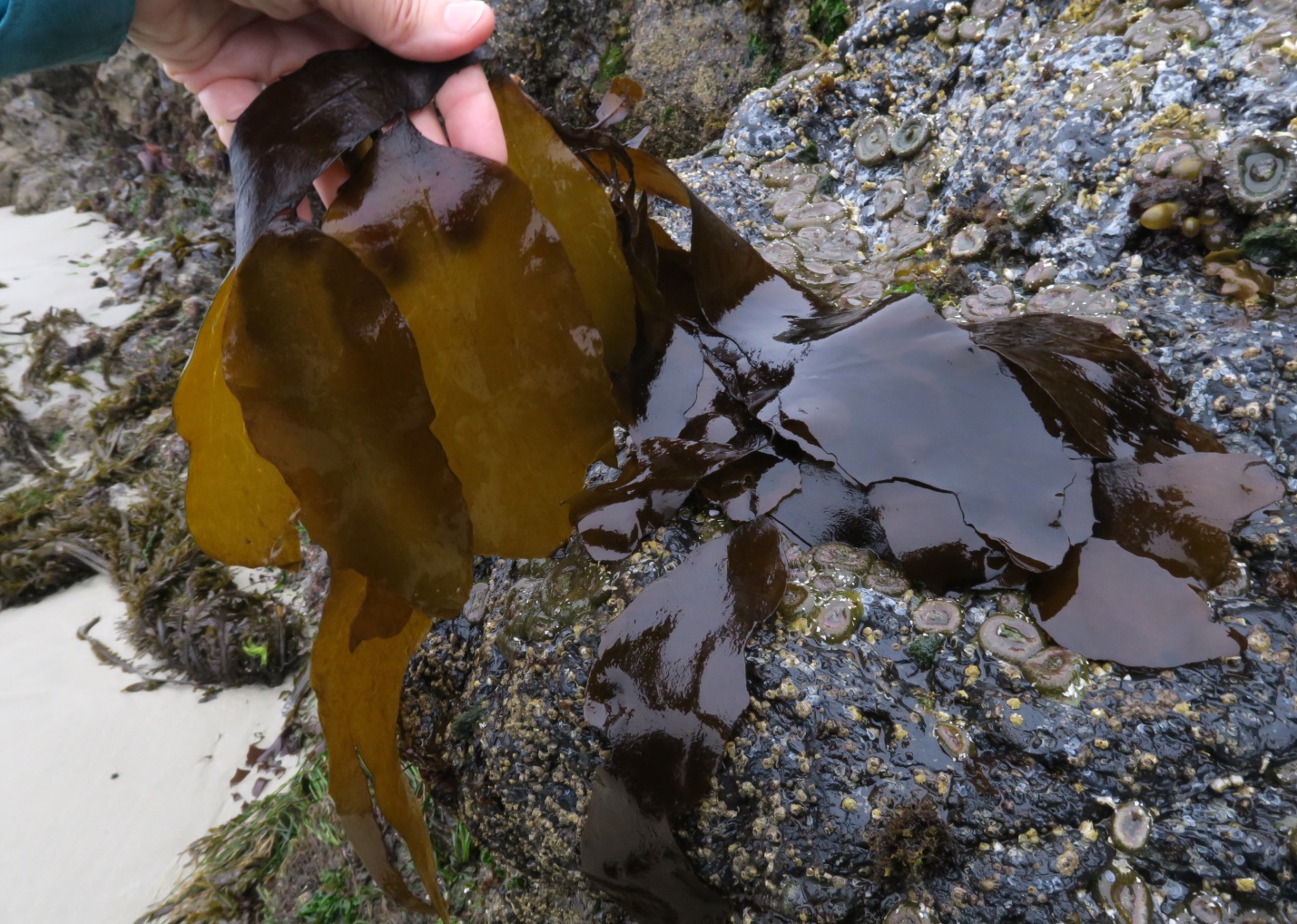
Figure 3: Held aloft, the color is revealed and the fine midribs. The broad blades overlap each other. On some of the darker looking blades that are resting on the rock damage is visible; interestingly any genus-characteristic bleaching is yet to occur. Tonquin Beach, Templar Channel, Vancouver Island, B.C., Canada. July 21, 2024. Photo ID 27710 ©Seaweedwhisperings.com
Discussion:
Content, smooth, pours out smoothly, effortlessly floating – all of these fit into a type of “things working out OK” energy and this is clearly a part of the characteristics of this seaweed.
They are not forcing their way through, yet they do progress onward. The energy is pouring out, spreading out, and all in a very smooth non-hurried way – one could call it seeping, this outward expansion. They haven’t got any doubts, they proceed at their own pace and there is the feeling that they don’t really have to try – that this movement is simply the most natural and inherent.
There is no hurry. There is no effort at striving.
We also thought of paddles and oars in this Whispering, and we can feel now that any paddle or oar that would be authentic to this seaweed’s nature is one that moves through water without breaking the surface. There are no splashes, there is no aggression, not even any hurry, yet the paddle gets the work done, seemingly effortlessly.
It would be lovely to have some underwater experience with this seaweed, as the broad blades might have the potential for behaviors we can’t quite imagine in the ‘cast ashore’ state. Person 1 did wonder if they might be belligerent if not allowed to effortlessly float. There is certainly the sense that they may bluntly state their preferences and choices, leaving no room for questions and really very little room for discussion either. It feels like they may have a certainty to the ‘rightness’ of their ways that can be experienced by others as direct, unequivocal and blunt.
With the observed slowness towards bleaching of this species, we felt they are on the whole “more forgiving” and gentle in their nature; their energy is not as “caustic” as other Desmarestia species we’ve interacted with. It is as if the acid trait is not strong, or perhaps it is that the forgiving trait is stronger than any wounding one. It is interesting to think of the combination of being unequivocal and direct but also forgiving, too.
Person 1 noted with early observed traits of this seaweed that there were some difficulties in finding accurate descriptors. And his explorations included examples that described polarities – smooth and rough, coarse and gentle. He felt unable to quite describe the feel of the seaweed..., was left wondering about the most fitting words. When we reviewed this point later we found we were content to leave the question unanswered. We also thought that this was showing us another trait of Desmarestia herbacea – they are skilled at recognizing what is answerable and what is not; as a result they embrace a type of gentle empowerment with that knowledge.
We interacted with this seaweed at the low tide closest to this month’s full moon. The full and rounded, ‘effortlessly floating’ and gentle nature of the moonlight are reflected well the qualities of this seaweed.
On the way up to our outer west coast field site, Person 2 observed a woman at a restaurant who seemed to be ‘poured into’ her clothing. Another description that fits is like a sausage bulging within its skin. This physical ‘look’ is not really uncommon, but on this day it struck Person 2’s perception in a notable way. This came to mind again while interacting with Desmarestia herbacea with the concepts of stubby or chubby or poured into and expanded fully into one’s skin. It is about FULL-ness we see now, as we felt the link to the full moon. The full moon is not obese but it is as full as full can get! A sausage is not easy to preserve or to cook if it is loose in its skin. This is about fullness, being complete, nothing is left out or missing.
Considering our seaweed once again, our new acquaintance Desmarestia herbacea... we wondered – what are they full of?
They have a fullness that is about possessing every last part that they need. And their needs seem to relate to themselves, to being full and complete in themselves. And from what we could understand, their needs don’t seem to be about their community..., or more accurately they don’t start out as being about their community. For them to feel ready to move out to the community and give assistance they need to have developed their personal ‘fullness’ first. Once that is in place, then expanding on out to meet others in important ways is OK.
With the phases of the moon, the moon is of course always all there, but depending on the angle with the sun and our point of view on earth, we only see parts of it illuminated. With Desmarestia herbacea, the personal fullness could be defined in this manner also – it is when they have all parts illuminated unto themselves.
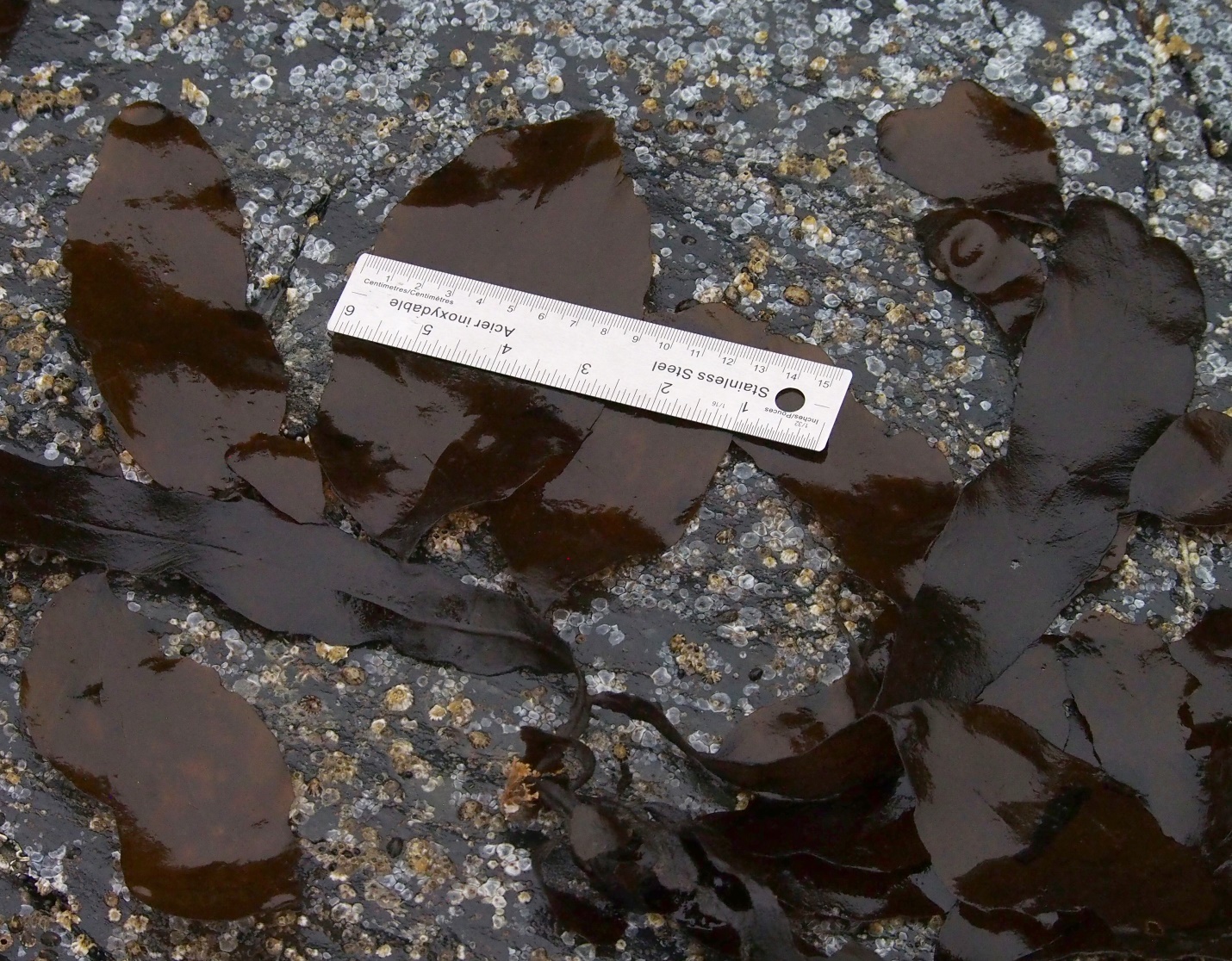
Figure 4: 9 centimeters wide is the measure of one of these Desmarestia herbacea bladelets. Tonquin Beach, Templar Channel, Vancouver Island, B.C., Canada. July 21, 2024. Photo ID 27711 ©Seaweedwhisperings.com
Biology & Natural History Information:
Description:
This brown alga has a conspicuous strap-like central axis that arises from a discoid holdfast. The main axis has a prominent thread-like mid-rib and lateral branches arise from both margins in regular rows. Faint midribs and veins may be evident running the length of the branches. Individuals can exceed 1 meter in length, and the branches of D. herbacea are wider than a close species, D. ligulata, whose branching is more profuse with individual narrow branches measuring less than 1 cm wide. “Flattened” is an apt term to describe the central strap and branches, as blades are broad but not thick.
Habitat:
Attached to rock in the lower intertidal and subtidal regions.
Distribution:
Alaska to Mexico.
Remarks:
Until recently there were sixteen species/forms of flattened and ligulate Desmarestia worldwide. Morphological and genetic relationships have been studied and now they are reorganized into fewer species and more subspecies. The rationale for this change is that while there were clear morphological and geographical differences between groups of Desmarestia, they were too few genetic differences to support separation into individual species.
Classification:
Phylum: Heterokontophyta
Subphylum: Ochrophytina
Class: Phaeophyceae
Order: Desmarestiales
Family: Desmarestiaceae
Genus: Desmarestia
Species: Desmarestia herbacea (Turner) J.V.Lamouroux 1813
Former name(s):
Homotypic synonyms: Fucus herbaceous Turner 1808; Laminaria herbacea (Turner) C.Agardh 1817; Desmia herbacea (Lamouroux) Postels & Ruprect 1840; Desmarestia ligulata var. herbacea (Turner) J.Agardh 1848. Heterotypic synonyms: Sporochnus herbaceous (Lamouroux) C.Agardh 1821; Desmarestia munda Setchell & N.L.Gardner 1924; Desmarestia Mexicana E.Y.Dawson 1944; Desmarestia munda subsp. mexicana (E.Y.Dawson) J.N.Norris 2001.
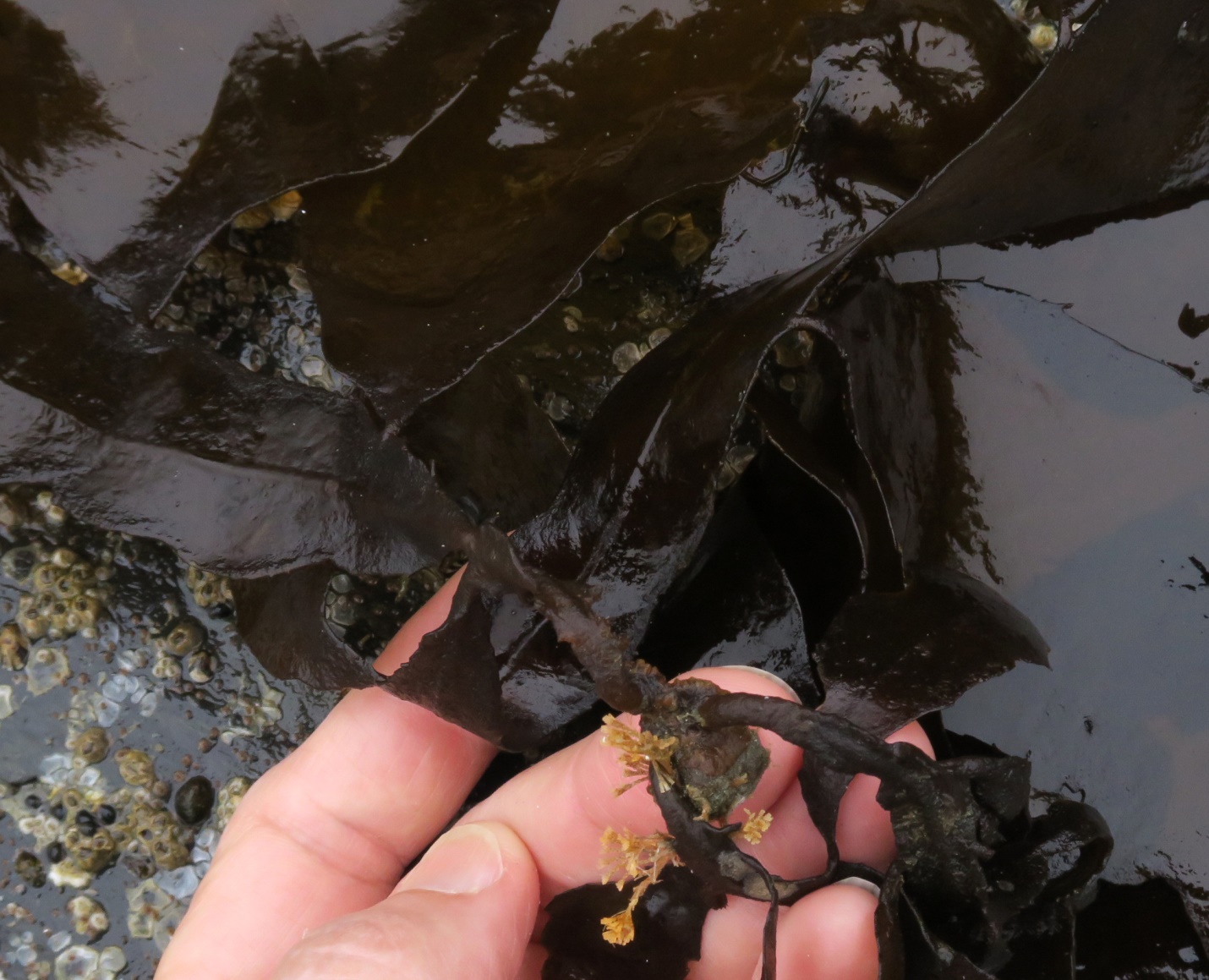
Figure 5: Resting on the pad Person 2’s middle finger is the shared discoid holdfast of these seaweeds. The size of it seems small in comparison to what it is anchoring, but perhaps the holding powers are not measured only in size! Tonquin Beach, Templar Channel, Vancouver Island, B.C., Canada. July 21, 2024. Photo ID 27712 ©Seaweedwhisperings.com
![]()